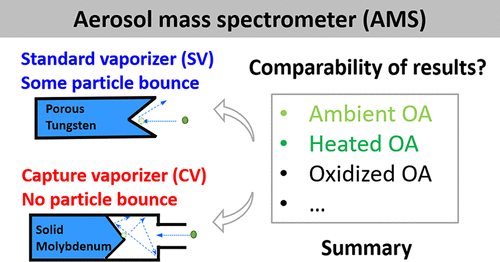当前位置:
X-MOL 学术
›
ACS Earth Space Chem.
›
论文详情
Our official English website, www.x-mol.net, welcomes your
feedback! (Note: you will need to create a separate account there.)
Ambient Quantification and Size Distributions for Organic Aerosol in Aerosol Mass Spectrometers with the New Capture Vaporizer
ACS Earth and Space Chemistry ( IF 2.9 ) Pub Date : 2020-02-17 , DOI: 10.1021/acsearthspacechem.9b00310 Weiwei Hu 1, 2, 3 , Pedro Campuzano-Jost 1, 2 , Douglas A. Day 1, 2 , Benjamin A. Nault 1, 2 , Taehyun Park 4 , Taehyoung Lee 4 , Aki Pajunoja 5 , Annele Virtanen 5 , Philip Croteau 6 , Manjula R. Canagaratna 6 , John T. Jayne 6 , Douglas R. Worsnop 6 , Jose L. Jimenez 1, 2
ACS Earth and Space Chemistry ( IF 2.9 ) Pub Date : 2020-02-17 , DOI: 10.1021/acsearthspacechem.9b00310 Weiwei Hu 1, 2, 3 , Pedro Campuzano-Jost 1, 2 , Douglas A. Day 1, 2 , Benjamin A. Nault 1, 2 , Taehyun Park 4 , Taehyoung Lee 4 , Aki Pajunoja 5 , Annele Virtanen 5 , Philip Croteau 6 , Manjula R. Canagaratna 6 , John T. Jayne 6 , Douglas R. Worsnop 6 , Jose L. Jimenez 1, 2
Affiliation

|
Aerodyne aerosol mass spectrometers (AMSs) or aerosol chemical speciation monitors (ACSMs) are widely deployed to quantify organic aerosol (OA) mass concentration and size distribution in various field and laboratory studies across the world. A nonunity collection efficiency (CE, usually 0.45–1), resulting from particle bounce (PB) on a standard vaporizer (SV), depends on the chemical composition and phase of the aerosol. The estimation of CE contributes a significant fraction of the total quantification uncertainty for these instruments. To address this uncertainty, a capture vaporizer (CV) was recently designed to reduce or eliminate PB. Here, we evaluate the quantification of ambient submicron OA with the CV, including multiple biogenic- and anthropogenic-influenced field studies. Good agreement of OA between the SV and CV has been found (slopes = 0.84–1, R > 0.9), consistent with both CE ≈ 1 for ambient OA with the CV and with the chemical composition-dependent CE (CDCE) previously developed for ambient SV data. The effects of oxidation and thermal denuding of aerosols on quantification using both vaporizers are also examined. No effect of the oxidation state of OA on quantification of SV and CV AMSs is observed. Our results show that the SV CDCE, which works well for ambient aerosols, overestimates the CE of OA after thermal denuding because of nominally increasing inorganic acidity upon heating. Size distributions of three laboratory-generated OA species have similarly delayed detection and broadened ratios in the CV versus SV as for (NH4)2SO4. The CV cannot measure size distributions at a lower vaporizer temperature (<500 °C for oleic acid and squalene and <350 °C for citric acid) because of too slow vaporization of OA. Finally, we summarize all the relevant pros and cons for using the CV versus SV in AMS and ACSM studies, which at present, point to the need to decide on the best vaporizer depending on the main objectives of a given instrument and study.
中文翻译:

新型捕获汽化器在气溶胶质谱仪中对有机气溶胶的环境定量和尺寸分布
Aerodyne气溶胶质谱仪(AMS)或气溶胶化学形态监测器(ACSM)广泛用于量化全球各个领域和实验室研究中有机气溶胶(OA)的浓度和大小分布。由标准蒸发器(SV)上的粒子反弹(PB)导致的不均匀收集效率(CE,通常为0.45-1),取决于气溶胶的化学组成和相。CE的估计在这些仪器的总定量不确定性中占很大一部分。为了解决这种不确定性,最近设计了一个捕集蒸发器(CV)来减少或消除PB。在这里,我们用CV评估了环境亚微米OA的定量,包括多个受生物和人为影响的野外研究。R > 0.9),与带有CV的环境OA的CE≈1和先前为环境SV数据开发的依赖化学成分的CE(CDCE)都一致。还检查了使用两种蒸发器进行的气溶胶氧化和热剥蚀对定量的影响。没有观察到OA的氧化态对SV和CV AMS定量的影响。我们的结果表明,SV CDCE非常适合环境中的气溶胶,由于加热时无机酸的名义上增加了,因此在热剥蚀后高估了OA的CE。与(NH 4)2 SO 4相比,三种实验室产生的OA物种的大小分布在CV与SV中具有相似的延迟检测和扩大的比率。由于OA的蒸发速度太慢,CV无法在较低的蒸发器温度下测量尺寸分布(油酸和角鲨烯<500°C,柠檬酸<350°C)。最后,我们总结了在AMS和ACSM研究中使用CV与SV的所有相关利弊,目前,这表明需要根据给定仪器和研究的主要目标来决定最佳蒸发器。
更新日期:2020-02-17
中文翻译:

新型捕获汽化器在气溶胶质谱仪中对有机气溶胶的环境定量和尺寸分布
Aerodyne气溶胶质谱仪(AMS)或气溶胶化学形态监测器(ACSM)广泛用于量化全球各个领域和实验室研究中有机气溶胶(OA)的浓度和大小分布。由标准蒸发器(SV)上的粒子反弹(PB)导致的不均匀收集效率(CE,通常为0.45-1),取决于气溶胶的化学组成和相。CE的估计在这些仪器的总定量不确定性中占很大一部分。为了解决这种不确定性,最近设计了一个捕集蒸发器(CV)来减少或消除PB。在这里,我们用CV评估了环境亚微米OA的定量,包括多个受生物和人为影响的野外研究。R > 0.9),与带有CV的环境OA的CE≈1和先前为环境SV数据开发的依赖化学成分的CE(CDCE)都一致。还检查了使用两种蒸发器进行的气溶胶氧化和热剥蚀对定量的影响。没有观察到OA的氧化态对SV和CV AMS定量的影响。我们的结果表明,SV CDCE非常适合环境中的气溶胶,由于加热时无机酸的名义上增加了,因此在热剥蚀后高估了OA的CE。与(NH 4)2 SO 4相比,三种实验室产生的OA物种的大小分布在CV与SV中具有相似的延迟检测和扩大的比率。由于OA的蒸发速度太慢,CV无法在较低的蒸发器温度下测量尺寸分布(油酸和角鲨烯<500°C,柠檬酸<350°C)。最后,我们总结了在AMS和ACSM研究中使用CV与SV的所有相关利弊,目前,这表明需要根据给定仪器和研究的主要目标来决定最佳蒸发器。











































 京公网安备 11010802027423号
京公网安备 11010802027423号